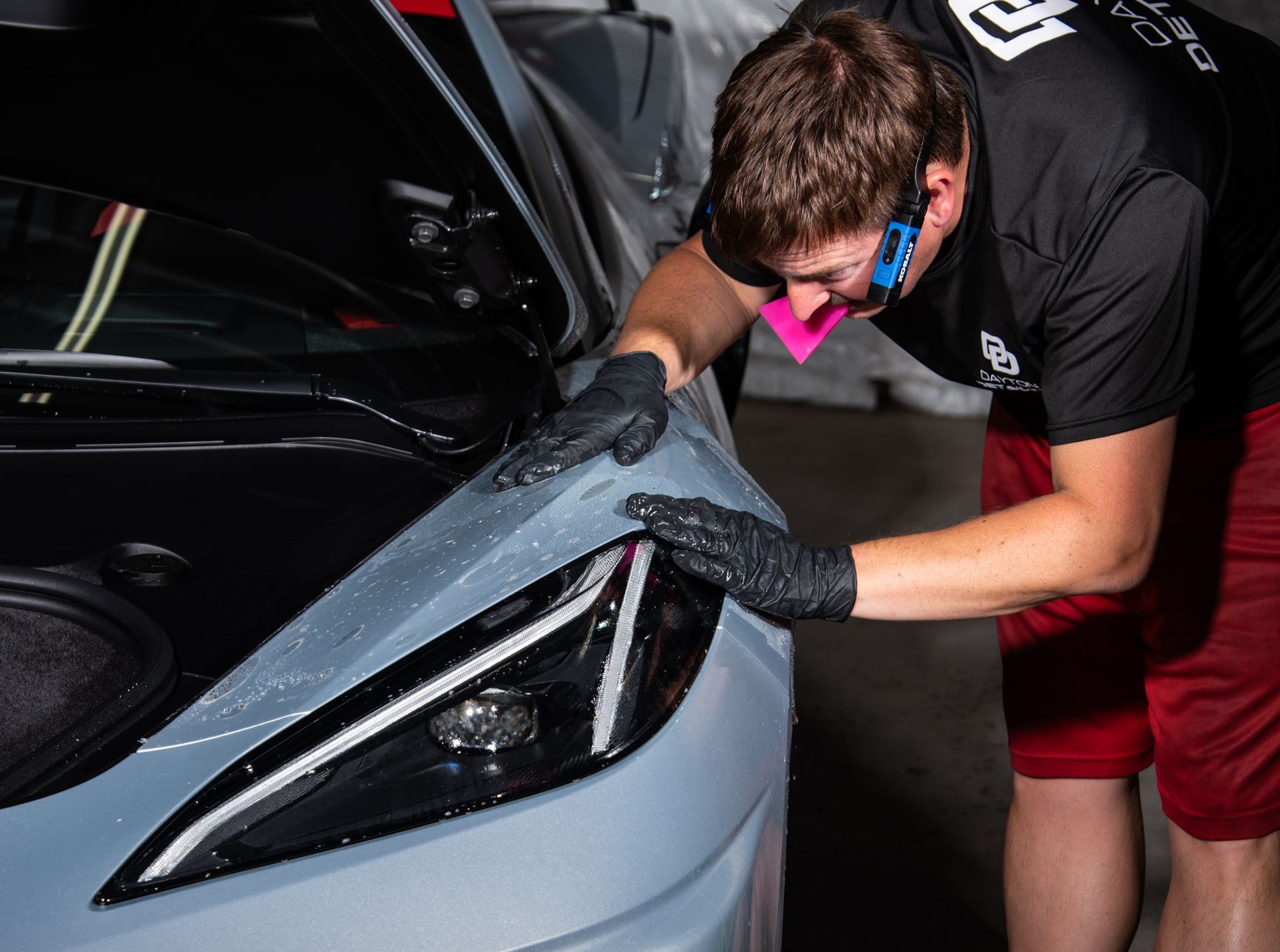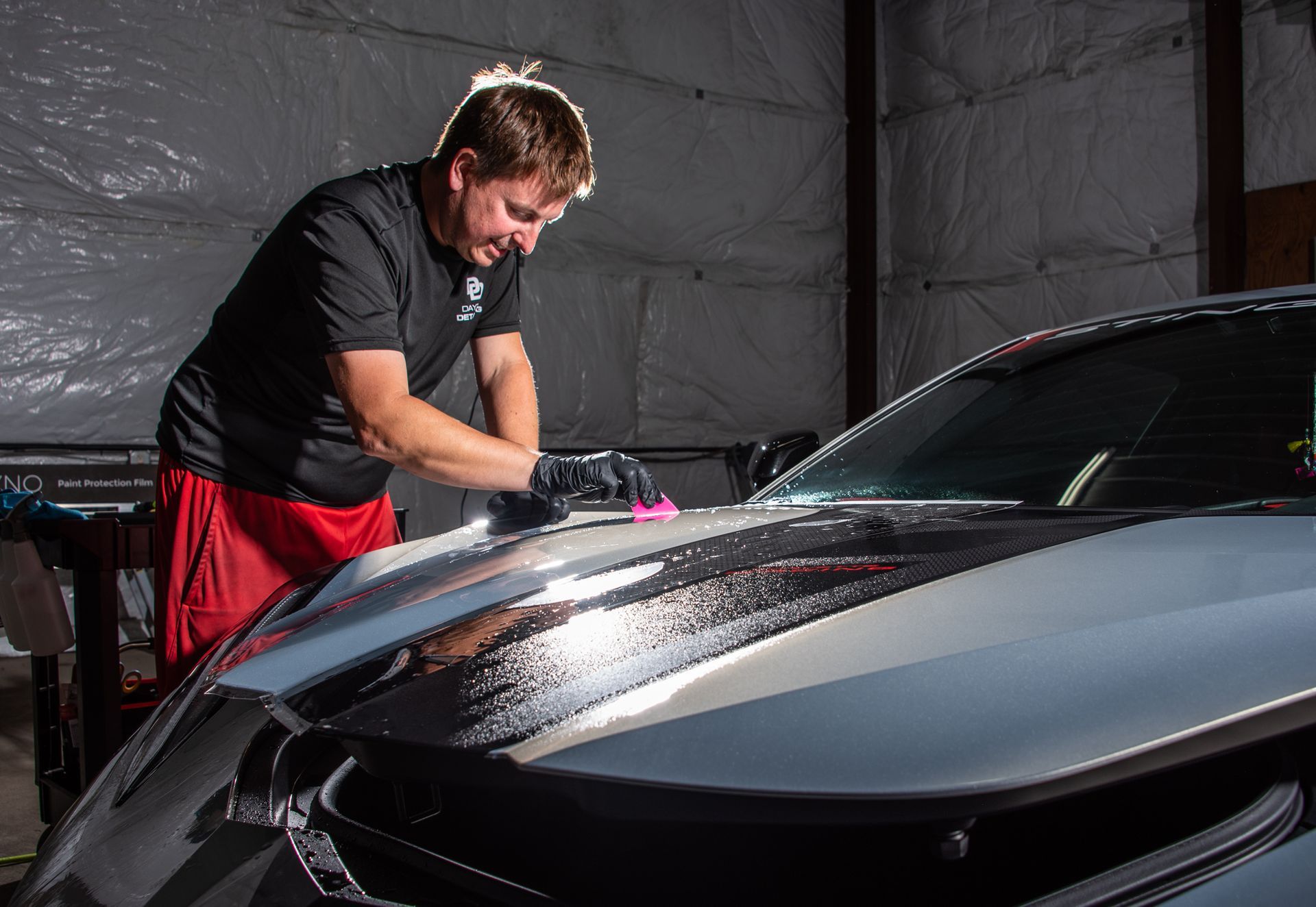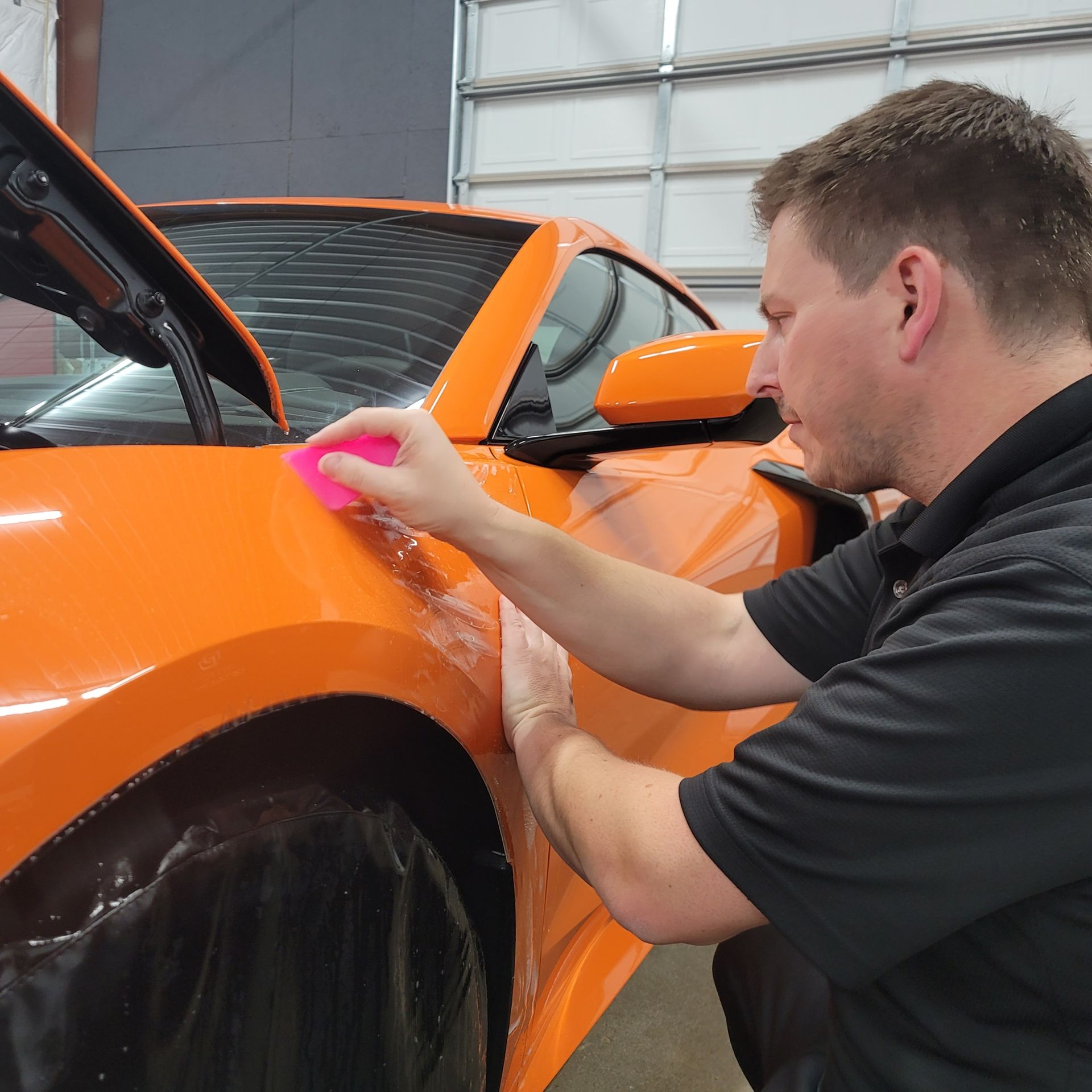Identify Common Signs of Paint Protection Film Wear and Tear in Your Vehicle
GET A FREE ESTIMATEWhen you invest in a new vehicle, you want to keep it looking sharp and protect that factory finish. That’s where paint protection film comes into play. It acts as a shield against scratches, dirt, and damaging UV rays, helping your car maintain its fresh-off-the-lot look for longer. However, just like any protective gear, PPF isn’t invincible; over time, it can show signs of wear and tear. Knowing what to look for is crucial.
Common signs of wear and tear on paint protection film include scratches, cracks, discoloration, lifting edges, and a noticeable loss of gloss. Regular inspections for these indicators are essential to maintain the film's protective qualities and ensure the longevity of your vehicle's paint.
Why Monitoring Paint Protection Film is Important
Regular monitoring of your paint protection film should become a part of your vehicle maintenance routine. By checking its condition routinely, you can identify common signs of wear and tear—issues like scratches or lifting edges—that could threaten both the film and the paint beneath it. Neglecting to assess the surface regularly may allow minor scuffs to develop into more significant cracks. Considering that 80% of PPF damage can be detected through simple visual inspections, this proactive approach is essential.
Imagine spending thousands on a vehicle only to watch it lose its luster due to improper care! Additionally, environmental factors like UV exposure and harsh weather play a significant role in the film’s longevity. Cars parked outdoors constantly face a barrage of sunlight and elements that can hasten degradation. By committing to regular checks, you're not just protecting your investment; you're also pushing back against natural deterioration caused by these external forces. It’s a bit like giving your vehicle a protective shield against potential perils.
To keep your paint protection film in top shape, consider these key inspection points:
- Scratches: Look for small abrasions that could compromise effectiveness.
- Cracks: Deep fissures indicate severe impact needing immediate evaluation.
- Discoloration: Watch for yellowing or fading as signs of UV damage.
- Lifting Edges: Promptly address lifting to prevent moisture intrusion.
- Loss of Gloss: A decrease below 80 gloss units signifies reduced protective capabilities.
Implementing a simple inspection process allows you to track the health of the film over time. Using tools like a gloss meter can help quantitatively assess the shine, or even running your hands over the surface can reveal texture changes indicating wear. Such attentive care enables you to act swiftly at the first sign of trouble, sidestepping larger, more costly repairs down the road. Consistent monitoring empowers you to maintain not just your car's aesthetics but also its integrity and resale value, helping you recognize emerging issues before they develop into more serious concerns.
Common Signs of Paint Protection Film Wear and Tear
- Scratches: One of the first signs of wear you'll likely encounter on your PPF is scratches. These small abrasions may seem insignificant at first, yet they can compromise the film's protective barrier, allowing dirt, dust, and other contaminants to seep through. Imagine driving down a gravel road; a loose stone flinging against your car can create a scratch—just a tiny blemish—but if that scratch goes unchecked, it might widen during subsequent washes.
- Cracks: Moving from superficial marks to more serious concerns, you might notice cracks developing in your film. These fissures are indicative of deeper issues, often resulting from impacts or stress applied to areas where the film stretches. They frequently appear in regions with complex curves or around edges where the film is most vulnerable. Left unattended, cracks can allow moisture and dirt to penetrate beneath the film, causing significant challenges over time.
- Discoloration: Another common indicator of wear is discoloration. Over time, exposure to harsh ultraviolet (UV) rays can cause your paint protection film to develop a yellowish hue or fade altogether. This change not only detracts from the vehicle's visual appeal but also signifies that the film's protective properties are deteriorating. Think of it as sunscreen for your car; just like human skin requires reapplication of sunscreen to fend off UV damage, your PPF needs attention too.
- Lifting Edges: Pay close attention to any lifting edges on your PPF, as these are critical areas that can signal trouble. When the edges begin to peel away from the vehicle surface, they expose the paint underneath to various environmental hazards. Additionally, trapped moisture in these lifted sections can lead to mold and further degradation of both the film and underlying paint. Addressing edge lift promptly involves re-adhering them properly because waiting can escalate minor damage into costly repairs down the line.
- Loss of Gloss: Lastly, be vigilant about monitoring for a loss of gloss. Over time, you might notice that the once vibrant shine begins to dull. Using a gloss meter can help quantify this issue—if readings fall below 80 gloss units (GU), it’s an indication that the protective capabilities of your paint protection film have diminished. Dullness not only decreases aesthetic value but also reflects how well it shields against external factors such as dirt and grime.
By honing in on these specific indicators of wear and taking proactive steps, you can greatly extend the life and effectiveness of your paint protection film while maintaining your vehicle's aesthetic appeal.
Causes of Premature PPF Wear
Paint protection film is a valuable investment for maintaining your vehicle's appearance, but several factors can lead to its premature wear and tear. By understanding these causes, you can take proactive steps to ensure your PPF lasts longer and performs effectively.
- Low-Quality PPF Choices: Opting for inferior-quality paint protection films is a common cause of premature wear. While they may be cost-effective upfront, these films often lack the durability and adhesion of premium options. Over time, they tend to peel back or lose their protective properties, reducing the overall value of your investment.
- Improper Installation: The installation process significantly impacts the performance of your paint protection film. Poorly applied films with bubbles, wrinkles, or uneven stretching fail to adhere properly, leaving areas vulnerable to dirt and moisture. Choosing a skilled, reputable installer ensures your film is applied correctly, preserving both its appearance and protective qualities.
- Inadequate Maintenance: Maintenance practices play a crucial role in the lifespan of your paint protection film. Harsh cleaning agents, especially those with acidic or abrasive properties, can damage the film's surface and strip away protective layers. Using gentle, PPF-specific cleaning solutions helps maintain the film's integrity and ensures it stays clear and effective.
- Environmental Exposure: Environmental factors can accelerate the deterioration of your PPF. Prolonged exposure to sunlight causes fading, while extreme temperature fluctuations can result in cracking or lifting edges. Vehicles frequently parked outdoors face higher wear rates than those kept in garages. Protecting your vehicle with a car cover or parking indoors helps mitigate these effects.
Understanding the causes of premature paint protection film wear allows you to take actionable steps to prolong its life. From choosing high-quality films and professional installers to adopting proper maintenance habits, each decision plays a crucial role in safeguarding your investment.
How to Inspect Your PPF
Regular inspections are essential for ensuring that your paint protection film remains intact and performs its protective role effectively. Start by conducting thorough visual inspections. This means scanning the surface carefully for any visible scratches, cracks, or areas of discoloration. Each of these signs can reveal important information about the film's condition. For example, scratches may indicate contact with abrasive surfaces, while discoloration often suggests sun damage from UV exposure, which can weaken the film's protective qualities over time.
It’s wise to invest in a gloss meter as part of your inspection toolkit. This device goes beyond mere visual assessments; it quantitatively measures the shine of your PPF. If you find that the gloss level dips below 80 gloss units (GU), this is a clear red flag that your film might be experiencing degradation. Maintaining a higher gloss level not only enhances your vehicle's appearance but also indicates that the film is still functioning effectively as a shield against contaminants.
Once you've conducted a visual check and used a gloss meter, it's time for a tactile examination of the film. Running your fingers over the surface will help you identify any textures that seem out of place. Rough spots or lifting edges can signal that adhesion has weakened or that there may be moisture trapped beneath the film. Detecting these problems early allows you to address them before they lead to more significant issues.
Staying vigilant with these inspection methods empowers you to maintain both the aesthetic appeal and protective integrity of your vehicle's paintwork.
Tips for Maintaining Your PPF
Maintenance is key when it comes to ensuring your paint protection film remains effective and looks its best.
- Gentle Washing Techniques: To start, it's important to adopt gentle washing techniques. Using a soft sponge or microfiber cloth alongside a mild car shampoo makes all the difference. This combination helps to lift away dirt without damaging the film. Remember, your goal is to keep the surface clean while avoiding any harsh scrubbing or high-pressure washes, as they can cause scratches and even peel the edges of the film.
- Regular Application of Sealants: Applying sealants specifically designed for PPF creates an additional barrier against environmental elements. It is recommended to do this every six months. Not only do sealants protect against UV rays that can lead to yellowing, they enhance the gloss and overall aesthetics of the film. While some folks might skip this step, an extra layer truly pays off in maintaining that showroom shine.
- UV Protection: Whenever possible, try to park your vehicle in shaded areas or use a breathable car cover. This simple action minimizes sun exposure, which can degrade the film over time. If you’re someone who regularly parks outside, think of a car cover as a protective blanket; it shields the paint protection film from harsh sunlight and helps keep your vehicle cooler inside on hot days.
- Avoid Harsh Chemicals: Steering clear of acidic or solvent-based cleaners cannot be overstated. Using products not suited for PPF can lead to degradation of its protective qualities. Imagine investing in something special just to have it compromised by the wrong cleaning agents; it’s simply not worth it. Read labels carefully and opt for pH-balanced options designed specifically for automotive care.
By applying these practices consistently, you are actively working towards prolonging the life of your PPF while ensuring it continues to perform at its best.
When to Consider Replacing Your PPF
Knowing precisely when to replace your PPF can save you considerably on future repairs, as well as time and frustration.
Persistent Cracks
For instance, persistent cracks are a clear red flag. If you notice multiple cracks across the film's surface, it signifies that the paint protection film has lost its ability to protect your vehicle effectively. This isn't just an aesthetic issue; these cracks can lead to deeper damage if left untreated, making replacement prudent.
Fading and Discoloration
Discoloration is another telltale sign of wear. If you observe a drastic change in color or clarity, particularly yellowing or cloudiness after several months of exposure, this usually means the film is succumbing to UV radiation. A faded appearance not only detracts from your vehicle's charm but may also indicate that it's no longer providing adequate protection against contaminants.
Severe Lifting and Peeling
Severe lifting and peeling are alarming indicators that shouldn't be overlooked. If large sections of the film are lifting off, it allows moisture to accumulate beneath, which can cause significant damage to the paint underneath. Moisture trapped in these areas can lead to rust and paint degradation—a costly problem that could have been avoided by replacing the PPF sooner.
Diminished Gloss
Additionally, if you've been conducting regular maintenance but find that a gloss meter reading consistently falls below 80 gloss units (GU), it’s wise to consider reapplying PPF. The loss of gloss reduces not just the aesthetics of your vehicle but also compromises its protective capabilities. Recognizing these signs is crucial for maintaining not only your vehicle's appearance but also its overall value over time.
Ultimately, regular inspections and awareness are essential for identifying problems early. Timely replacements preserve your car’s pristine condition and guard against larger expenses down the road. By staying vigilant and proactive about paint protection film conditions—addressing persistent issues like cracks, discoloration, lifting edges, and loss of gloss—you enhance your investment's longevity while elevating the aesthetics of your ride.
Leading Provider of PPF Services in Dayton
Protect your vehicle with the
premier paint protection film services
offered by Dayton Detailing, the leading provider in Dayton, OH. Our expertly installed PPF shields your car’s paint from chips,
scratches, and environmental hazards, preserving its pristine appearance for the long term. Using top-quality materials and precision techniques, we deliver a seamless finish that enhances both protection and style. Give your car the care it deserves—contact Dayton Detailing today to schedule your PPF installation! Call (937) 409-9337 to get started!
Share with your friends
Better Than New is What We Do
Dayton Detailing opened its doors in late 2017, ensuring every customer that their vehicle would not simply go through another run-of-the-mill car wash and instead, look fully transformed upon leaving. From detailing our own vehicles to spreading this skill to as many vehicles in the Dayton, Ohio area, Dayton Detailing delivers excellent ceramic coating, PPF, paint correction, and overall vehicle care provider. If you are searching for custom-tailored detailing services, Dayton Detailing is the shop you want!
Quick Links
Our Location
3876 Indian Ripple Rd, Suite B, Dayton, OH 45440 United States
Connect With Us
Phone: (937) 409-9337
Designed by the team at Detailers Roadmap, a platform developed for detailing operators across the globe.
All Rights Reserved | 8bitcreative, LLC | Dayton Detailing





